
Tibetan Buddhism is a form of Buddhism practiced in Tibet and Mongolia. It also has a sizable number of adherents in the areas surrounding the Himalayas, including the Indian regions of Ladakh, Sikkim, and Arunachal Pradesh, as well as Bhutan and Nepal. Smaller groups of practitioners can be found in Central Asia, Xinjiang, Inner Mongolia, and some regions of Russia, such as Tuva, Buryatia, and Kalmykia.

Vajrayāna, along with Mantrayāna, Guhyamantrayāna, Tantrayāna, Secret Mantra, Tantric Buddhism, and Esoteric Buddhism, are names referring to Buddhist traditions associated with Tantra and "Secret Mantra", which developed in the medieval Indian subcontinent and spread to Tibet, Nepal, other Himalayan states, East Asia, and Mongolia.

A mandala is a geometric configuration of symbols. In various spiritual traditions, mandalas may be employed for focusing attention of practitioners and adepts, as a spiritual guidance tool, for establishing a sacred space and as an aid to meditation and trance induction. In the Eastern religions of Hinduism, Buddhism, Jainism and Shinto it is used as a map representing deities, or especially in the case of Shinto, paradises, kami or actual shrines. A mandala generally represents the spiritual journey, starting from outside to the inner core, through layers.

Buddhist symbolism is the use of symbols to represent certain aspects of the Buddha's Dharma (teaching). Early Buddhist symbols which remain important today include the Dharma wheel, the Indian lotus, the three jewels and the Bodhi tree.
Buddhist culture is exemplified through Buddhist art, Buddhist architecture, Buddhist music and Buddhist cuisine. As Buddhism expanded from the Indian subcontinent it adopted artistic and cultural elements of host countries in other parts of Asia.
Yidam is a type of deity associated with tantric or Vajrayana Buddhism said to be manifestations of Buddhahood or enlightened mind. During personal meditation (sādhana) practice, the yogi identifies their own form, attributes and mind with those of a yidam for the purpose of transformation. Yidam is sometimes translated by the terms "meditational deity" or "tutelary deity". Examples of yidams include the meditation deities Chakrasamvara, Kalachakra, Hevajra, Yamantaka, and Vajrayogini, all of whom have a distinctive iconography, mandala, mantra, rites of invocation and practice.
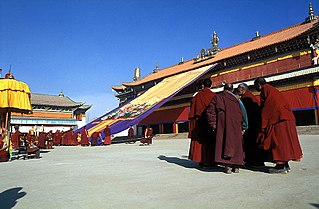
Ngawa or Aba town is the seat of Ngawa (Aba) County, within the Ngawa (Aba) Tibetan and Qiang Autonomous Prefecture in northwestern Sichuan, China. It is located on the Tibetan plateau at an elevation of 3,200 metres (10,500 ft). The city is about 75 km (47 mi) from Jigdril, 254 km from Barkham (Ma'erkang) and 157 km (98 mi) from Mewa (Hongyuan).

Sera Monastery is one of the "great three" Gelug university monasteries of Tibet, located 1.25 miles (2.01 km) north of Lhasa and about 5 km (3.1 mi) north of the Jokhang. The other two are Ganden Monastery and Drepung Monastery. The origin of its name is attributed to a fact that during construction, the hill behind the monastery was covered with blooming wild roses.

A ganacakra is also known as tsok, ganapuja, cakrapuja or ganacakrapuja. It is a generic term for various tantric assemblies or feasts, in which practitioners meet to chant mantra, enact mudra, make votive offerings and practice various tantric rituals as part of a sādhanā, or spiritual practice. The ganachakra often comprises a sacramental meal and festivities such as dancing, spirit possession, and trance; the feast generally consisting of materials that were considered forbidden or taboo in medieval India like meat, fish, and wine. As a tantric practice, forms of gaṇacakra are practiced today in Hinduism, Bön and Vajrayāna Buddhism.
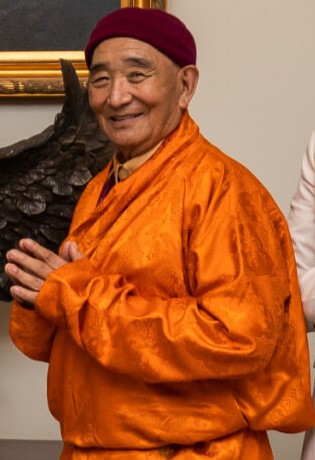
Tarthang Tulku is a Tibetan teacher (lama) who introduced the Nyingma tradition of Tibetan Buddhism into the United States, where he works to preserve the art and culture of Tibet. He oversees various projects including Dharma Publishing, Yeshe-De, Tibetan Aid Project, and the construction of the Odiyan Copper Mountain Mandala. Tarthang Tulku also introduced Kum Nye into the West.
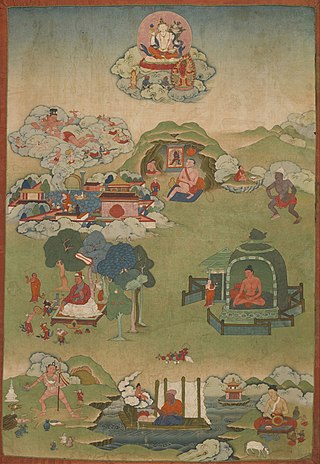
Tibetan tantric practice, also known as "the practice of secret mantra", and "tantric techniques", refers to the main tantric practices in Tibetan Buddhism. The great Rime scholar Jamgön Kongtrül refers to this as "the Process of Meditation in the Indestructible Way of Secret Mantra" and also as "the way of mantra," "way of method" and "the secret way" in his Treasury of Knowledge. These Vajrayāna Buddhist practices are mainly drawn from the Buddhist tantras and are generally not found in "common" Mahayana. These practices are seen by Tibetan Buddhists as the fastest and most powerful path to Buddhahood.
A prostration is a gesture used in Buddhist practice to show reverence to the Triple Gem and other objects of veneration.
Rizong gompa, Gelugpa or Yellow Hat Buddhist monastery is also called the Yuma Changchubling in Ladakh, India. It is situated at the top of a rocky side valley on the north side of the Indus, to the west of Alchi on the way to Lamayuru. It was established in 1831 by Lama Tsultim Nima under the Gelukpa order, at Ri-rdzong. There are 40 monks in the monastery. The monastery is also called "the paradise for meditation" and is noted for its extremely strict rules and standards. The nunnery, located about 2 km from the monastery, is called the "Jelichun Nunnery" or Chulichan (Chomoling), where, at present, 20 nuns reside.
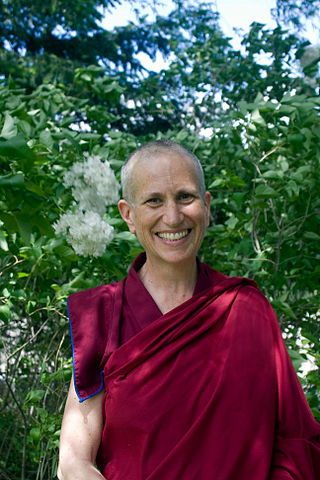
Thubten Chodron, born Cheryl Greene, is an American Tibetan Buddhist nun, author, teacher, and the founder and abbess of Sravasti Abbey, the only Tibetan Buddhist training monastery for Western nuns and monks in the United States. Chodron is a central figure in the reinstatement of the Bhikshuni ordination of women. She is a student of the 14th Dalai Lama, Tsenzhab Serkong Rinpoche, Lama Thubten Yeshe, Thubten Zopa Rinpoche, and other Tibetan masters. She has published many books on Buddhist philosophy and meditation, and is co-authoring with the Dalai Lama a multi-volume series of teachings on the Buddhist path, The Library of Wisdom and Compassion.
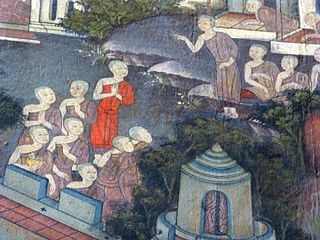
Women in Buddhism is a topic that can be approached from varied perspectives including those of theology, history, anthropology, and feminism. Topical interests include the theological status of women, the treatment of women in Buddhist societies at home and in public, the history of women in Buddhism, and a comparison of the experiences of women across different forms of Buddhism. As in other religions, the experiences of Buddhist women have varied considerably.
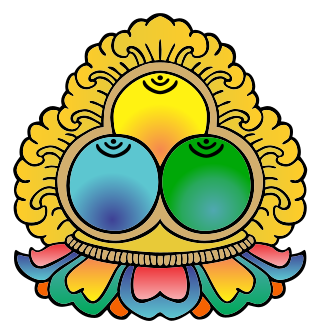
In Buddhism, the Three Jewels, Triple Gem, or Three Refuges are the supports in which a Buddhist takes refuge by means of a prayer or recitation at the beginning of the day or of a practice session.
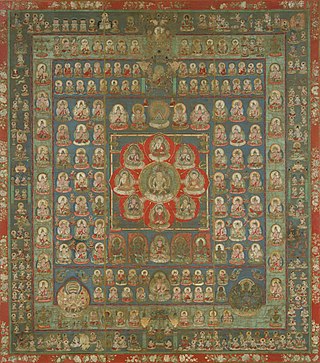
The Vairocanābhisaṃbodhi Sūtra, also known as the Mahāvairocana Tantra is an important Vajrayana Buddhist text composed before 674 CE. The Indian tantric master Buddhaguhya classified the text as a caryātantra, and in Tibetan Buddhism it is still considered to be a member of the carya classification. In Japan where it is known as the Mahāvairocana Sūtra, it is one of two central texts in the Shingon school, along with the Vajrasekhara Sutra. Both are also part of the Tendai school.
The Khamtrul tulku lineage is part of the Dongyud Palden section of the Drukpa Lineage of the Kagyu school of Tibetan Buddhism.

Tengboche Monastery, also known as Dawa Choling Gompa, in the Tengboche village in Khumjung in the Khumbu region of eastern Nepal is a Tibetan Buddhist monastery of the Sherpa community. Situated at 3,867 metres (12,687 ft), the monastery is the largest gompa in the Khumbu region of Nepal. It was built in 1916 by Lama Gulu with strong links to its mother monastery known as the Rongbuk Monastery in Tibet. In 1934, it was destroyed by an earthquake and was subsequently rebuilt. In 1989, it was destroyed for a second time by a fire and then rebuilt with the help of volunteers and international assistance.
Classes of Tantra in Tibetan Buddhism refers to the categorization of Buddhist tantric scriptures in Indo-Tibetan Buddhism. Tibetan Buddhism inherited numerous tantras and forms of tantric practice from medieval Indian Buddhist Tantra. There were various ways of categorizing these tantras in India. In Tibet, the Sarma schools categorize tantric scriptures into four classes, while the Nyingma (Ancients) school use six classes of tantra.













